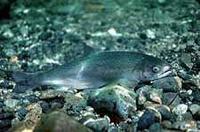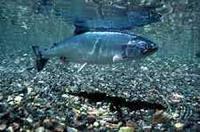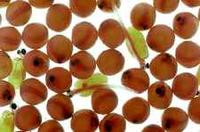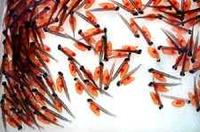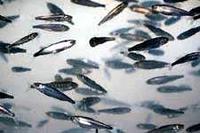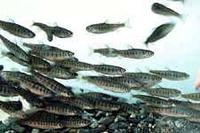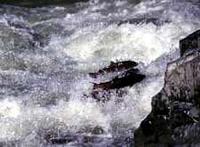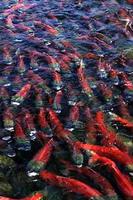Salmon, Pacific
SALMON, PACIFIC, genus Oncorhynchus, inhabits the coastal waters of northern Pacific Rim countries and is found in N America from San Francisco to Alaska and in coastal areas of Russia, Japan and Korea. Seven species of salmon are recognized: pink (Oncorhynchus gorbuscha); chum (O. keta); coho (O. kisutch); sockeye (O. nerka); chinook (O. tshawytscha); masu or sakura-masu (O. masou); and amago or biwamasu (O. rhodurus). The first 5 species listed occur in the eastern Pacific along the central and northern coasts of N America. The other 2 occur in the western Pacific from the southern rivers of the Kamchatka Peninsula south to waters around Taiwan, and are considered to be more trout-like than other members of the genus. An eighth member of this genus that occurs in BC, STEELHEAD (Oncorhynchus mykiss), is a sea-run rainbow TROUT. Steelhead are considered by some scientists to resemble the ancestral Pacific salmon type. The fact that there are a number of different species in this genus may be linked with early interglacial periods during the Pleistocene, when the ice melted for a time and sea levels rose to incorporate previously landlocked areas in which some evolutionary changes had already begun. This theory would account for the many similarities among the species.
Life Cycle
Pacific salmon are considered to be among the most commercially and socially valuable fish in BC. They are large, agile and fast-growing; they perform tremendous migrations; they have complex and interesting behaviour patterns. All Pacific salmon are anadromous, which means the fish spawns in fresh water but spend some, if not all, of its adult life in the salty ocean. The life stages of anadromous salmon are egg, embryo, alevin, fry, smolt and adult (spawner). After emerging from their gravel spawning beds (called redds) in freshwater streams and lakes, the young fry may spend anywhere from a few days to 3 years in fresh water. They then become smolts—physiological changes occur so they can live in salt water and they are on their way to becoming mature adults—and they migrate to the sea. In the ocean they disperse across a wide area of the N Pacific. At the end of their life cycle (1–7 years) mature adults return, generally in summer and fall, to the river systems in which they were born to spawn and die.
The use of salmon for personal consumption and for trading began with FIRST NATIONS hundreds of years ago. Whole cultures, both coastal and inland, were sustained by salmon; for some coastal groups the resource was so rich that particularly intricate cultural, artistic and social lives could flourish; the salmon became a cultural and religious icon among many groups.
The HBC pioneered the commercial fishery when it began salting fish at FORT LANGLEY in the 1830s. Canneries appeared on the lower FRASER R in the 1870s, then spread up the coast as SALMON CANNING developed into a major industry. Canned salmon was almost the only processed product until the 1960s, when improved refrigeration allowed a market for fresh and frozen fish to develop. As well, recreational fishers from around the world are attracted to these magnificent game fish. See also FISHERIES POLICY; FISHING, COMMERCIAL; FISHING, SPORT.
Numbers of the various species of salmon fluctuate greatly from year to year depending on many factors, but have been in a generally steady decline since the 1980s. In the late 1990s, the abundance particularly of coho, chinook and sockeye declined sharply due to a combination of factors: primarily overfishing, but also poor ocean survival, loss and deterioration of spawning habitat due mainly to urban and industrial developments in the lower Fraser R and LOGGING in coastal areas, and gear and vessel types that enable large hauls. Governments have responded to this crisis by instituting strict catch limits for both commercial and recreational fisheries, in hopes that stocks will rebuild.
Sockeye
Sockeye (Oncorhynchus nerka) primarily spawn in LAKES; a notable exception in BC is the lower STIKINE R system, in which a significant percentage are considered to be "main stem spawners." Young sockeye remain in fresh water generally for a year before migrating to the sea as smolts, where they remain up to 4 years. Average weight at maturity is 1.8–2.3 kg, though some reach up to 7 kg. Their deep red flesh and good flavour appeals to consumers. Sockeye was the mainstay of the early salmon canning industry and by 2000 was still the most important species commercially. The main coastal sockeye spawning areas are the SKEENA, Fraser and NASS rivers, and the Somass–Great Central Lake system on VANCOUVER ISLAND. Between 1986 and 1995 (before the more recent dramatic decline in populations), commercial fishers took an average of 10 million sockeye annually, while sport fishers caught an additional 20,000. In 2004 the wholesale value of the sockeye catch was $99.1 million. KOKANEE are freshwater-resident (commonly called landlocked) sockeye that do not migrate to salt water.
Pink
Pink (O. gorbuscha) is the most abundant salmon species in BC. After emergence from the gravel, the fry migrate almost immediately to the sea, where they remain for 18 months before returning to their natal rivers. The pink is the smallest species, with an average adult weight of 1–2.5 kg. It has a 2-year lifespan and tends to spawn in ESTUARIES and close to the sea. Pinks are also known as humpbacks, a reference to the hump that develops, particularly in mature males. Between 1986 and 1995 commercial fishers took an average of 14.5 million pink salmon annually, while sport fishers caught an additional 220,000. The wholesale value of the catch in 2004 was $23.1 million.
Chum
Chum, or dog salmon (O. keta), are the most widely dispersed salmon, occurring in about 800 BC streams. They generally spawn in the lower portions of RIVERS. At maturity their average weight is 5 kg and many exceed 9 kg. They return to their natal streams 3–7 years after hatching. The chum is the least popular species with consumers, owing to its low oil content. Between 1986 and 1995 commercial fishers took an average of 3.5 million annually. In 2004 the catch was worth $47.3 million wholesale.
Chinook
Chinook (O. tschawytscha), also called spring, is the largest Pacific salmon; adults can reach 40 kg and the largest rod-caught specimen on record, taken in the Skeena R in the 1950s, weighed 41.4 kg. Some are stream-type and spend one or more years in fresh water before migrating seaward. Chinook may also return to their natal rivers several months before spawning. Others are ocean-type; they migrate to sea after a few weeks or months and return to their natal streams only to spawn and die. The migration of both types generally peaks in spring, but may take place at any time of year. Chinook are highly sought-after sport fish. An individual exceeding 13.5 kg is known popularly as a TYEE. Between 1986 and 1995 commercial fishers took an annual average of 540,000 chinook, while sport fishers caught an additional 140,000. The 2004 catch was worth $26.7 million at wholesale prices.
Coho
Coho (O. kisutch) is also a favourite species with anglers. Spawning in about two-thirds of the known salmon-bearing streams in BC, it generally spends a year in fresh water before migrating to the sea. On average coho are 3 years old at maturity and an average mature weight is 3–5 kg. It is rare for an individual to exceed 9 kg. Between 1986 and 1995 commercial fishers took an annual average of 3 million coho. The wholesale value of the 2004 catch was $19.2 million. Sport catches during the same period averaged 1.3 million, but had declined drastically to 25,000 by 1998. Much of that decline was due to severe catch restrictions throughout coastal BC, imposed to conserve stocks.
Reading: C. Groot and L. Margolis eds, Pacific Salmon Life Histories, 1991; C. Groot, L. Margolis, W.C. Clarke, Physiological Ecology of Pacific Salmon, 1995.

